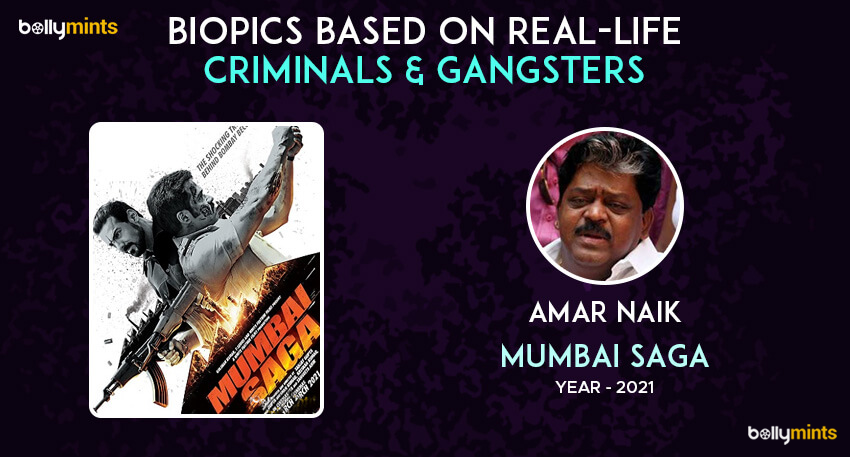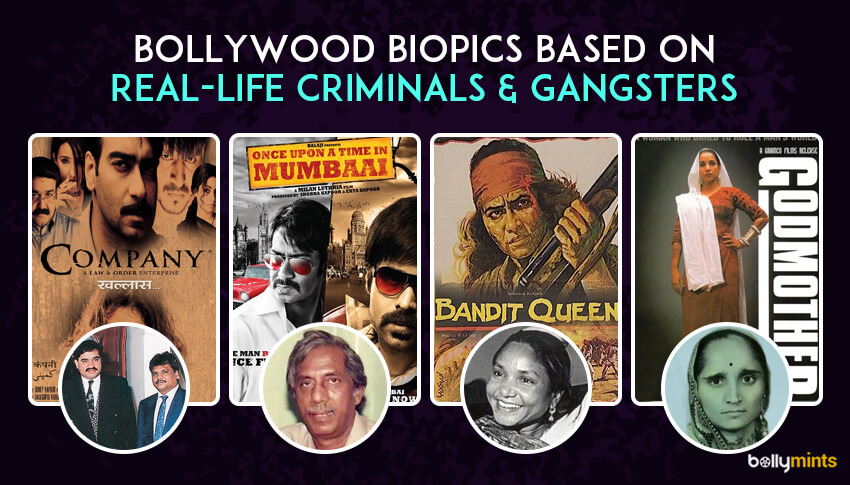Bollywood Biopics Based On Real-Life Criminals And Gangsters
Posted On: 29 Nov 2021 | Last Updated : 09 Mar 2022 | Views : 7.2k
The underworld criminals interest everyone because of their unsophisticated yet secretive lifestyle. This is the main reason why any news related to gangster, gang war, underworld, etc. becomes the headlines or the top news of the nation. The same pattern could be seen in Bollywood, where an action crime drama inspired by a true crime or underworld always does excellent at the box office. A movie based on real-life events or true people is often realistic and relatable, which makes it easy for the audience to empathize or understand the characters. Thus, a Bollywood movie based on a real-life gangster makes it realistic yet dramatic, which is full entertainment served on the plate. These gangster biopics attempt to dig deep into the minds of the criminals and try to portray their thoughts while committing a crime and also give a glimpse of the functioning of the criminal world. Here’s the list of Bollywood movies based on the most notorious real-life criminals that you must watch:
1. Dayavan (1988) – Varadarajan Mudaliar
Varadarajan Mudaliar was an Indian gangster and smuggler based in Mumbai. He was originally from Tamil Nadu and moved to Mumbai in 1945 and started working as a porter there. Initially, he stole dock cargo, however, he soon expanded his criminal activities to extortion, kidnapping, contract killing, illegal gambling, etc. He was like a Robin Hood to people from South India living in Mumbai during the 1960s, 1970s, and 1980s, his popularity among the South Indian slum residents of Mumbai helped create a massive haven for himself in the Dharavi slums and expand his criminal activities easily. He carried out the smuggling business with crime bosses Haji Mastan and Karim Lala, and this infamous trio of mafia leaders soon rose to power. Varadarajan Mudaliar’s life was straight out of movies and director Mani Ratnam took on the task to portray it on the silver screen in his 1987 epic crime drama Nayakan, starring Kamal Haasan in the lead role. Later, in 1988, Feroz Khan made the Bollywood remake of Nayakan, Dayavan with Vinod Khanna in the title role of Shakti Velu aka Dayavan.
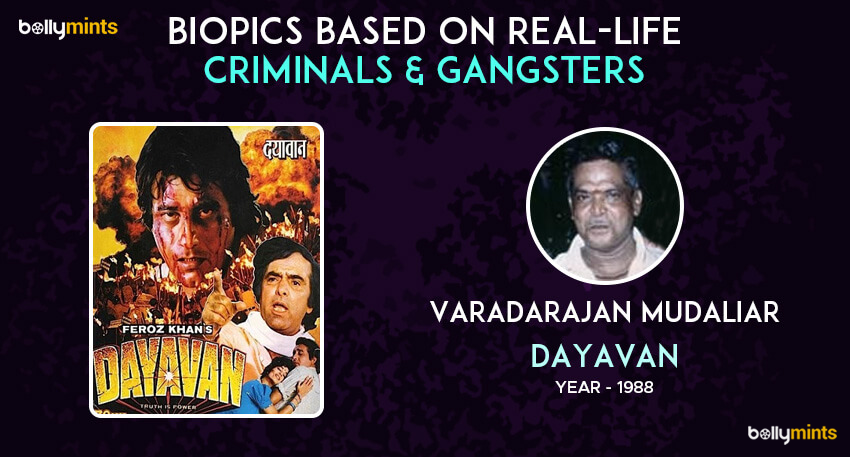
2. Bandit Queen (1994) – Phoolan Devi
Shekhar Kapur’s 1994 film Bandit Queen was based on the life of female bandit Phoolan Devi. The movie stars Seema Biswas as Phoolan Devi and tells her story which was already covered in the book ‘India’s Bandit Queen: The True Story of Phoolan Devi’ by the author Mala Sen. Phoolan Devi was the victim of child marriage. At the age of 11, she was married to a man named Puttilal Mullah, who was in his 20s. With her husband, she was continuously exposed to sexual and exploitative abuses. She decides to run away from her husband and joins the famous dacoit gang of Vikram Mallah. This starts Phoolan’s relationship with Vikram and the two become co-leaders of the gang. Thereafter, Phoolan’s life as a bandit commences. Bandit Queen, thus, is the story of the woman who becomes a bandit because of the social circumstances.
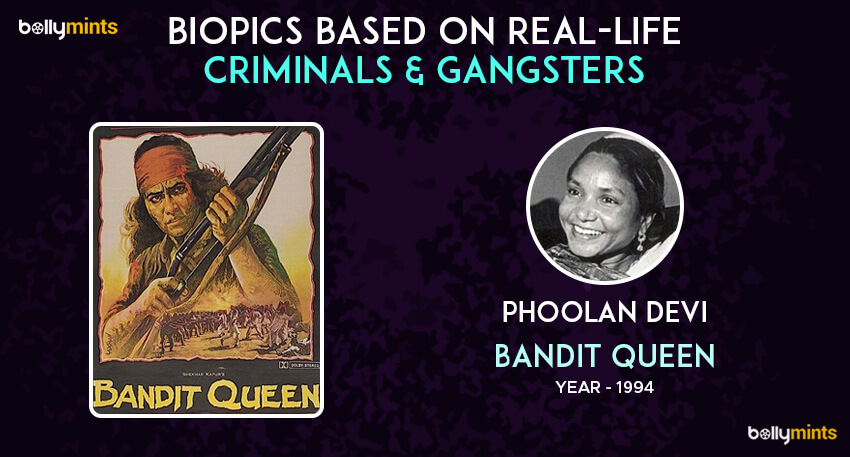
3. Ravan Raaj: A True Story (1995) – Auto Shankar
Mithun Chakraborty starrer Ravan Raaj: A True Story is an action drama inspired by Tamil blockbuster Pulan Visaranai, which is loosely based on the life of serial killer Auto Shankar. Gowri Shankar, better known as Auto Shankar, was a gangster based in Tamil Nadu, who was active throughout the 1970s and 1980s. He was merely an auto driver, who started transporting illegal liquor, and also worked as a pimp and supplied girls in the bungalows of VIPs. During the late 1980s, Shankar rose to power and had connections with most powerful and influential people. He used to brutally kill and bury all those who tried to go against him, and was often hired for political assassinations. T. Rama Rao’s 1995 film Ravan Raaj: A True Story features Shakti Kapoor as the main antagonist Auto Kesariya, the character inspired by Auto Shankar.
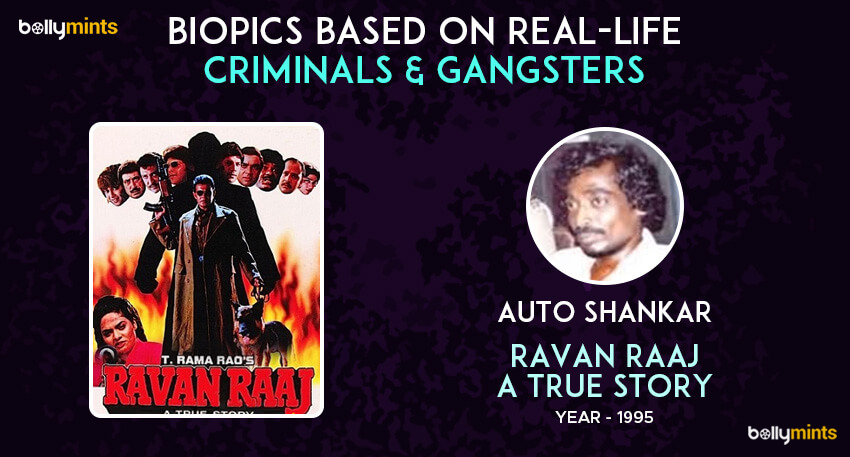
4. Godmother (1999) – Santokben Jadeja
The National Film Award winning 1999 film Godmother is the biographical drama based on the life of Indian criminal turned politician, Santokben Jadeja (played by Shabana Azmi). Santokben Jadeja was married to Sarman Munja Jadeja, an ordinary mill worker, whose life changed when he killed a local gangster Devu Vagher. Following the event, Sarman Munja Jadeja became a gangster and don, and in 1986, he was shot dead by a rival gang. Husband’s death enraged Santokben Jadega and she decided to turn to the criminal worlds to get things even. Thus, a simple housewife turned to a criminal due to the circumstances. Santokben was alleged to kill 14 people, whom she believed were responsible for her husband’s murder. Her criminal operations started in the 1980s and lasted till 1990s. Later, she turned into an MLA and even contested for the elections. Her role in the movie earned actress Shabana Azmi National Film Award for Best Actress.
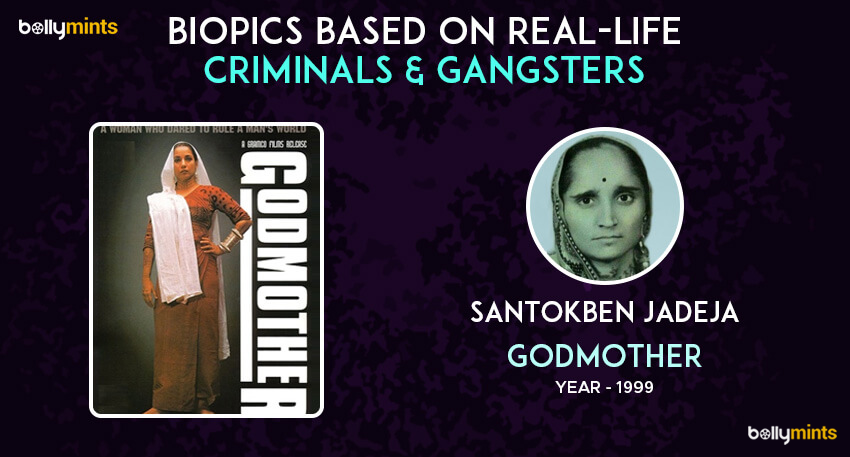
5. Company (2002) – Dawood Ibrahim / Chhota Rajan
Ram Gopal Varma directed the 2002 gangster film Company is loosely based on D-Company’s activities and majorly covers the fallout between the gangsters Dawood Ibrahim and Chhota Rajan. Dawood Ibrahim is an Indian gangster and kingpin, who heads the criminal organization D-Company and is the most wanted criminal of India since the 1993 Mumbai bombings. Chhota Rajan, the Indian criminal, and gangster, who is wanted for a number of criminal cases on his name. Chhota Rajan became the right hand of Dawood Ibrahim during his war with the rival gang of Arun Gawli in the late 1980s. However, the two parted their ways in 1993, after the Mumbai bombings as Chhota Rajan wanted to maintain his image of patriotic gangster don. Thereafter, Chhota Rajan formed his independent gang. The title character of the movie Company (2002), N. Malik (Ajay Devgn) and Chandrakant ‘Chandu’ Nagre (Vivek Oberoi) are inspired by Dawood Ibrahim and Chhota Rajan, respectively.
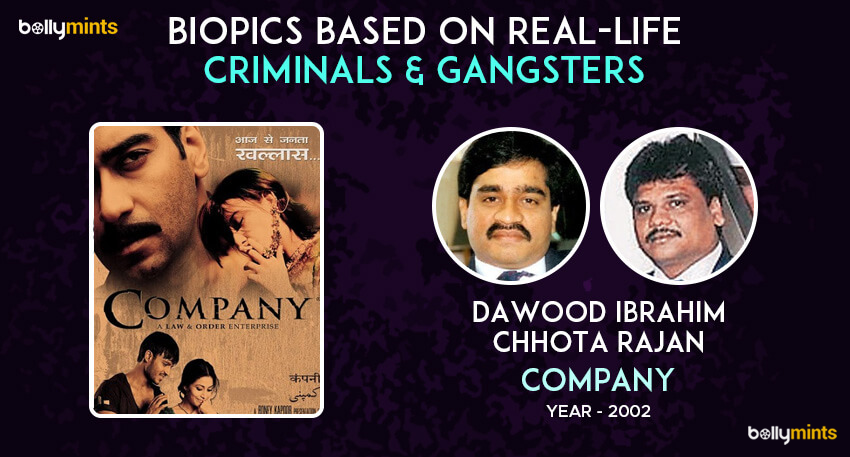
6. Shootout at Lokhandwala (2007) – Maya Dolas
If at all there would be a list of top 10 Bollywood real life gangster or criminal biopics, Sanjay Gupta’s Shootout at Lokhandwala would surely make it to the list. This Bollywood movie is based on the real-life infamous gangster, Maya Dolas. Mahendra Dolas aka Maya Dolas was a gangster who worked for Dawood Ibrahim. In 1980, he joined politician Ashok Joshi’s gang and soon rose to higher rank in the gang after a series of successful extortions. He became the most wanted criminal in the late 1980s. On 16th November 1991, Mumbai Police was tipped about Maya Dolas’ whereabouts. The team of police officers led by Police Commissioner Aftab Ahmed Khan surrounded the Lokhandwala Complex where Maya Dolas, along with Dilip Buwa and four other Dawood’s henchmen, was staying. This ensued a four-hour shootout in Lokhandwala and Maya Dolas was killed in the encounter. The movie very well dramatizes the encounter of the gangster, and was majorly shot on the actual location at Lokhandwala Complex. The movie was a major commercial success and became one of the most important movies of actor Vivek Oberoi, who played the role of Maya Dolas in the movie.
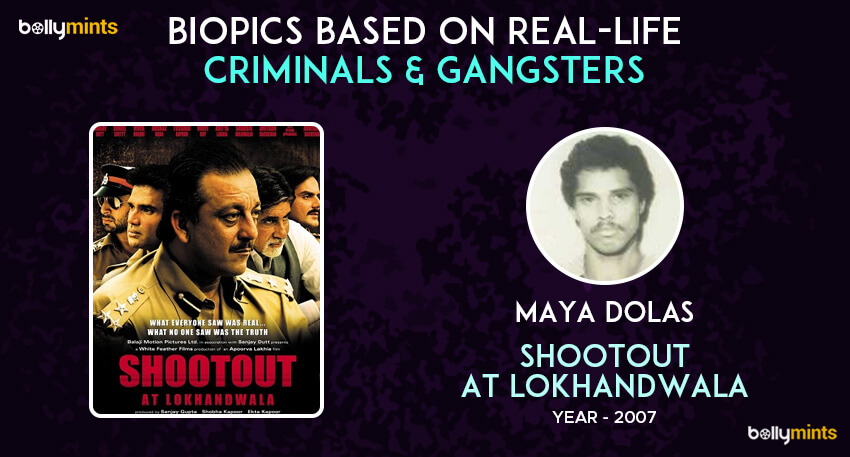
7. The Stoneman Murders (2009)
The 2009 crime thriller drama, The Stoneman Murders is based on the real-life serial killings in the early 1980s in Bombay. The name Stoneman was given by the print media of Calcutta, India to an unidentified serial killer who murdered homeless people in Bombay during their sleep in early 1980s and the similar pattern was seen in the series of murders in Calcutta in late 1980s. In the movie, we see a suspended police officer Sanjay Shelar (Kay Kay Menon), with the aid of his superior, tries to track down the serial killer targeting the homeless, who has already murdered five people. Sanjay realizes that the ruthless murders are done to perform a tantric ritual and collects evidences about the murderer. However, things are much more complicated than they appear.
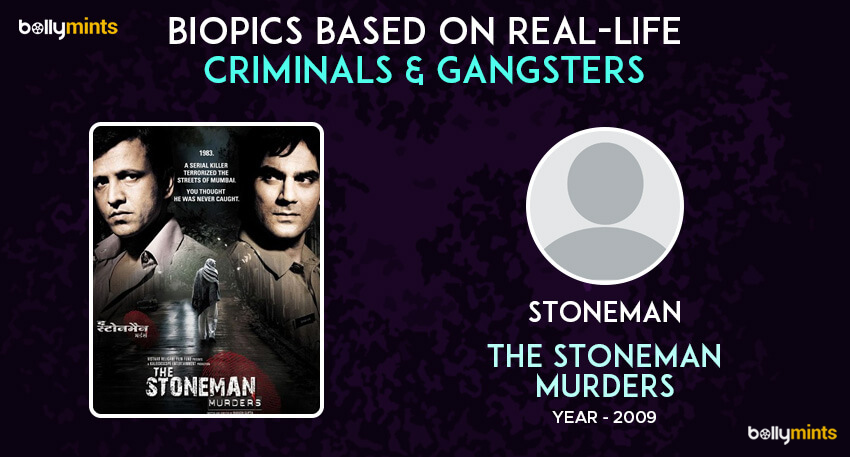
8. Once Upon a Time in Mumbaai (2010) – Haji Mastan
Milan Luthria’s 2010 gangster film Once Upon a Time in Mumbaai is loosely based on the lives of Mumbai underworld gangster Haji Mastan. Haji Mastan was an Indian mafia leader, originally from South India, based in Bombay and ruled the underworld in Bombay from 1960s to 1980s. He operated a powerful smuggling business in Mumbai and had connections with powerful political leaders and good relations with the police and government officials. Initially he worked in docks that made it easy to operate his smuggling business and soon became one of the most influential mafia leaders who had good terms with other gang leaders. The title characters of the movie Once Upon a Time in Mumbaai, Sultan Mirza (Ajay Devgn) and Shoaib Khan (Emraan Hashmi) are based on Haji Mastan and Dawood Ibrahim, respectively. Movie portrays major life events of Haji Mastan and the era when Mumbai’s underworld got organised under the leadership of Mastan. It also throws light on the rise to power of Mastan’s disciple Dawood Ibrahim after Haji Mastan’s downfall. With Its dramatic narrative and catchy dialogues, the movie was an instant hit. This movie, however, was not the first movie inspired by Haji Mastan’s life, Amitabh Bachchan’s role in Deewaar (1975) was also loosely based on the life of this smuggler.
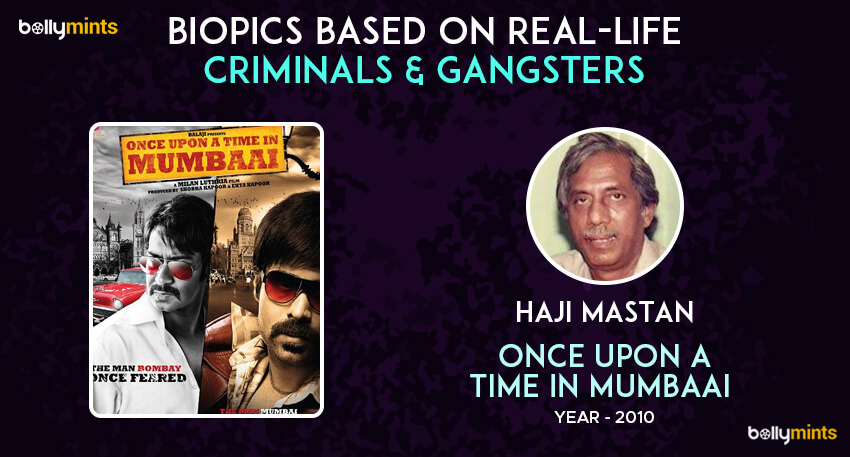
9. Paan Singh Tomar (2012)
Paan Singh Tomar, the 2012 biographical film, is based on the life of soldier-turned-dacoit Paan Singh Tomar (played by Irrfan Khan). Paan Singh Tomar was an Indian soldier, who was born in a small village of Bhidosa, near Porsa, Madhya Pradesh in British India. He served in the Indian Army, where his talent of running was discovered, and soon he became an athlete who participated in several national and international level tournaments and also won a gold medal. He took early retirement in 1977 and returned to his village to settle his family’s land disputes. Babbu Singh Tomar, a powerful landowner, was the grandson of Dayaram Singh Tomar, Paan Singh Tomar’s uncle. Babbu Singh Tomar captures most of the fertile land belonging to the Tomar family and later assaults Paan Singh Tomar’s old mother. Enraged Paan Singh Tomar turns into a rebel and goes on to kill Babbu Singh Tomar and the other eight villagers. After the incident, Paan Singh Tomar became a notorious dacoit who took shelter in Chambal Valley and there was a price of Rs. 10,000 on his head.
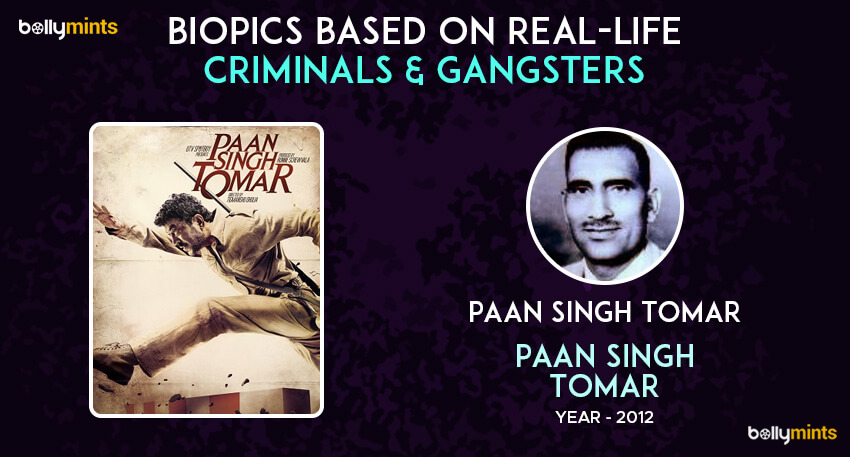
10. Shootout at Wadala (2013) – Manya Surve
The 2013 action gangster crime film Shootout at Wadala is based on the encounter by Mumbai Police in which gangster Manya Surve was shot dead. Manya Surve was an educated gangster who challenged and defeated many existing gangs. He soon rose to prominence and helped the Pathan gang led by Karim Lala in murdering gangster Shabir Ibrahim, brother of Dawood Ibrahim. He started expanding his criminal activities in the 1970s and 1980s, when other gangs were trying to spread their influence. In the movie John Abraham portrays the role of Manya Surve and the movie revolves around the 1982 encounter at Wadala. Post Shabir Ibrahim’s murder, Surve’s gang members started to fall off one by one and Surve became the target of Maharashtra police, who killed him in the encounter. This was Mumbai police’ first recorded encounter, and the rate of encounters of wanted gangsters increased gradually. Audience liked the storyline and dramatic shots, and the movie turned out to be a successful venture of director Sanjay Gupta.
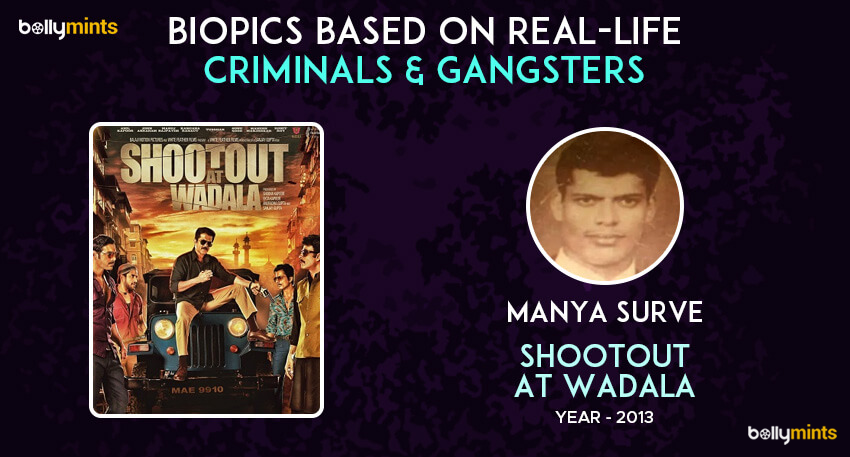
11. Main Aur Charles (2015) – Charles Sobhraj
The 2015 crime drama Main Aur Charles was inspired by the true events from the life of the Indian descent French serial killer Charles Sobhraj. The movie is told from the perspective of the Indian police officer Amod Kanth (Adil Hussain), who handled the case of Charles Sobhraj (Randeep Hooda). The narrative follows the series of crimes committed by Charles and stories of his victims. Charles Sobhraj was born to an Indian father and Vietnamese mother, but his father denied paternity, so his mother married a French man. He felt neglected when his mother had more children with his stepfather and soon, he began to commit penny crimes. Later, he targeted tourists, whom he first befriended and later robbed. He also used to steal the passports of the tourists and escaped from one country to another with his partner. He then gathered his followers who helped him carry out the criminal activities in different countries of Asia and escape from police. He was fluent in several languages and used his charm to make people fall in his trap. He murdered around 20 people and was named ‘The Bikini Killer’ because of the similar of attire of his victims.
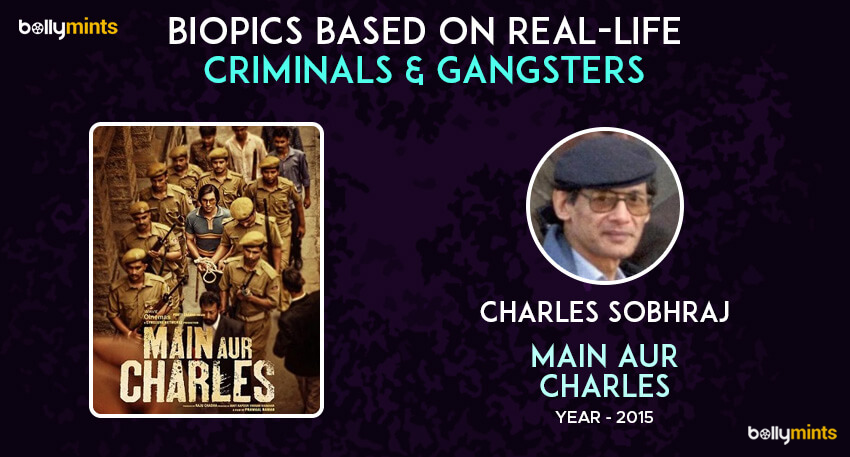
12. Raman Raghav 2.0 (2016) – Raman Raghav
Anurag Kashyap’s psychological crime drama Raman Raghav 2.0 is inspired by the real-life killer Raman Raghav, who operated in Mumbai during the 1960s. A series of murders took place in 1965 and 1966, when around 19 people were attacked. Raman Raghav, a homeless man, was suspected to be behind the murders, but the police let him go as no solid evidence was found against him. In 1968, same pattern of murders took place and during the manhunt, the police caught Raman Raghav red-handed. In his confession, he admitted to have murdered 41 people in 1966 and about dozen in 1968. The intention behind the murders was never clear, however, it was claimed that Raman Raghav was suffering from schizophrenia. Raman’s sentence was reduced from death penalty to life imprisonment due to his incurable mental illness. In the movie, we see the setting of the movie in the contemporary time and the title character of the movie, Ramanna (Nawazuddin Siddiqui) is a modern adaptation of psycho killer Raman Raghav.
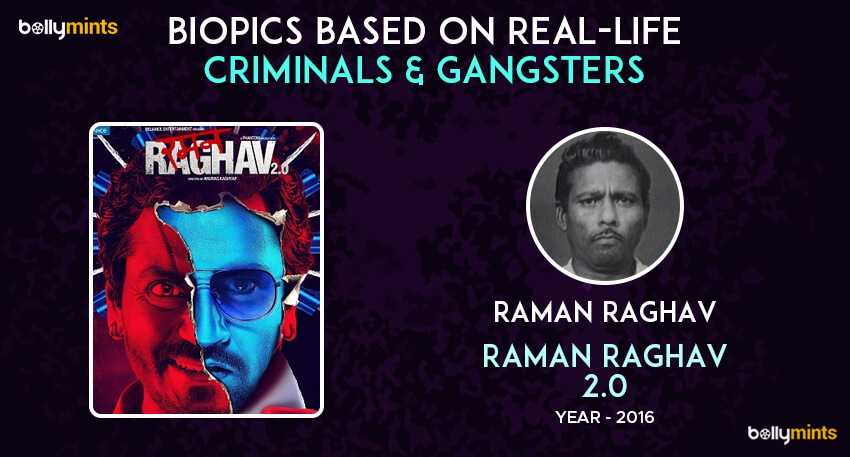
13. Veerappan (2016)
Ram Gopal Verma’s Veerappan is a biographical action crime drama based on the real-life bandit Veerappan (played by Sandeep Bharadwaj). Koose Muniswamy Veerappan, popularly known as Veerappan, was a bandit hailing from Tamil Nadu. He used to kidnap major politicians and celebrities for ransom and also smuggled sandalwood and poached elephants in the forests of Tamil Nadu, Karnataka, and Kerala. In his teenage years, he started working for his uncle Saalvai Gounder, who was a notorious smuggler and poacher. He committed his first murder at the age of 17 and then began killing everyone who resisted him. Veerappan killed around 184 people and most of his victims were senior police officers, police informants, and forest officials. The political instability made it easier for Veerappan to escape from one state to another. The bandit turned domestic terrorist and became the most wanted criminal and the battle to capture him cost the government over Rs. 100 crore. In 2004, a Special Task Force team led by an undercover cop Vijay Kumar set out to capture Veerappan and his associates and finally put an end to the terror.
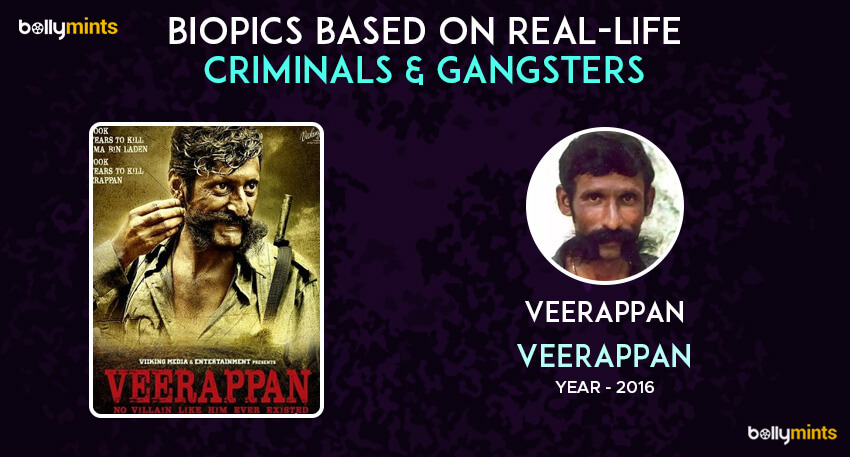
14. Daddy (2017) - Arun Gawli
The 2017 political crime drama, Daddy is co-written and produced by actor Arjun Rampal. The movie is based on the real-life gangster-turned-politician Arun Gawli (played by Arjun Rampal). In the 1960s or 1970s, the Mumbai textile mills witnessed a series of strikes and eventually shut down, which resulted in unemployment for a number of mill workers, including Arun Gawli. To make quick money, he resorted to ‘matka’ gambling and later joined the gang led by gangsters Rama Naik and Babu Reshim. Arun Gawli is caught by police on a number of occasions but escapes conviction due to lack of evidence. Throughout the late 1980s and 1990s, Arun Gawli and his gang struggled with a powerful rival gang. In late 1990s, he formed his own party Akhil Bharatiya Sena. How the most dreaded criminal lands up in politics and his journey to becoming ‘Daddy’ forms the rest of the plot of the movie.
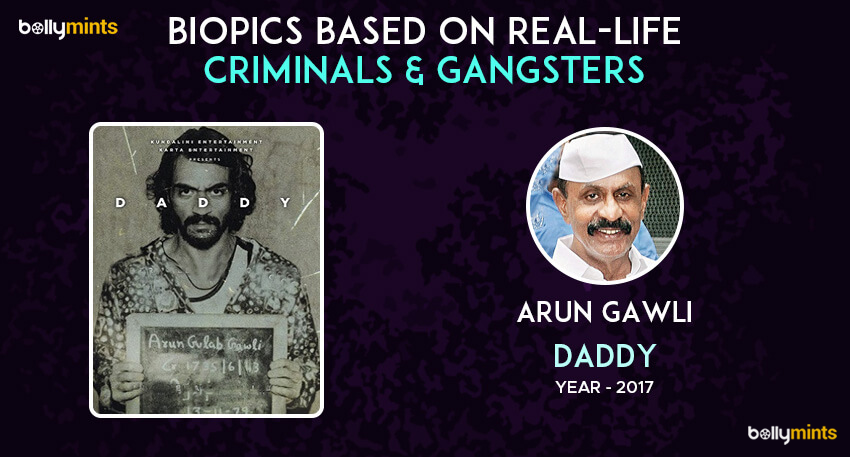
15. Haseena Parkar (2017)
Apporva Lakhia’s biographical crime drama Haseena Parkar is based on the life of Indian gangster and drug kingpin, Dawood Ibrahim’s (played by Siddhanth Kapoor) younger sister Haseena Parkar (played by Shraddha Kapoor). Out of 12 siblings, Haseena Parkar was the seventh child, while Dawood was the third. In 1991, Haseena’s husband Ibrahim Parkar was shot by gangster Arun Gawli. After the death of her husband, she shifted to a new home which was the beginning of her transformation from a housewife to the ‘Godmother of Nagpada’, who emerged as Aapa (older sister) in Mumbai’s male dominated underworld. The 1993 bomb blasts in Mumbai creates a situation of shock and Dawood emerges as one of the conspirators, but he escapes to Dubai and Haseena falls in trouble. However, Haseena denies her connections with her brother, and declares that she was merely an innocent bride who was forced to turn to the criminal world.
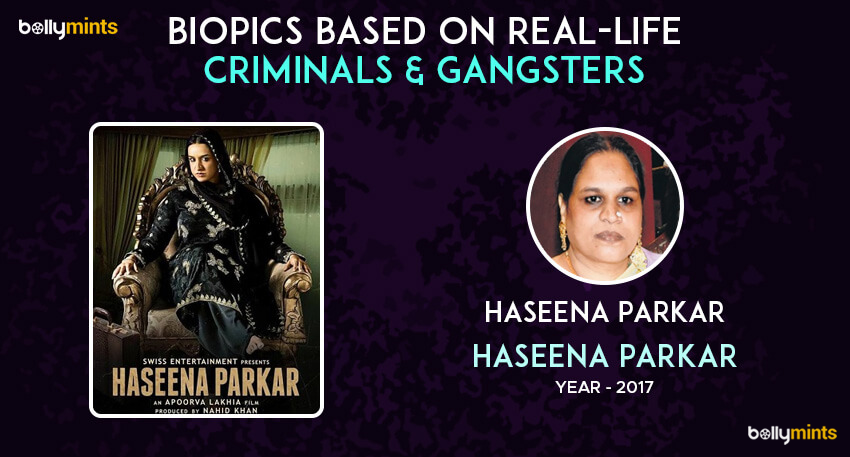
16. Raees (2017) – Abdul Latif
Shah Rukh Khan starrer 2017 action crime drama Raees is said to be based on the life of the criminal Abdul Latif. Abdul Latif was an underworld gangster based in Gujarat and was also an associate of Dawood Ibrahim. He became a bootlegger and monopolised the illegal liquor business in Gujarat. Latif had over 100 cases on his name, which included murder, kidnapping, extortion, smuggling, bootlegging etc. He was also the key supplier of RDX used in the 1993 Mumbai blasts. The title character of the movie, Raees Alam Hussain, was inspired by Abdul Latif but the filmmakers denied it later and declared it to be a work of fiction after one of Abdul Latif’s sons filed a lawsuit against the filmmakers for misrepresenting his father’s character. Abdul Latif had several cases lodged in his name but he did not run a brothel or use women for his illegal business as shown in the movie.
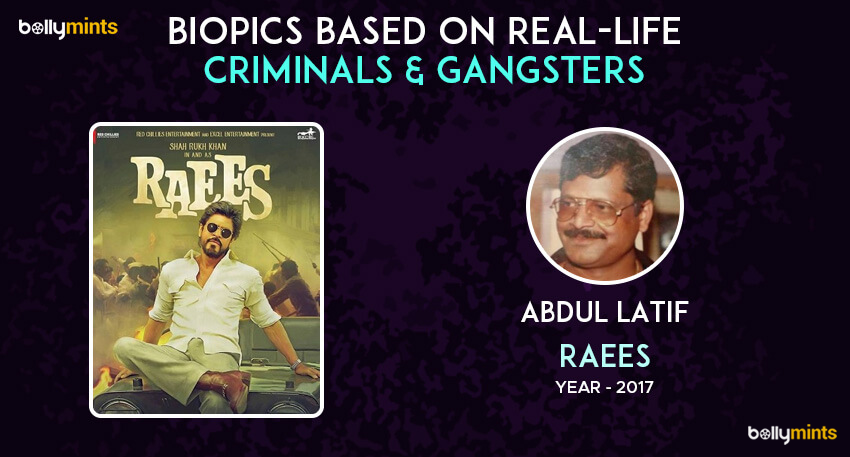
17. Mumbai Saga (2021) – Amar Naik
The 2021 action crime drama Mumbai Saga is another gangster movie of director Sanjay Gupta that is loosely based on the encounter of a real-life gangster. The main antagonist of the movie Amartya Rao (John Abraham) is based on Amar Naik, brother of gangster Ashwin Naik, who was one of the most wanted gangsters of the 1990s. He ruled major parts of Maharashtra like Pune, Dadar, Paral, etc. Initially he earned his living by selling vegetables, however, his life changed when he was introduced to the criminal underworld. He was linked to top gang leaders like Dawood Ibrahim, Chhota Rajan, Haji Mastan, Arun Gawli, etc. The movie follows Amar Naik’s major life events, his rise to power and ultimately his encounter in 1996.
